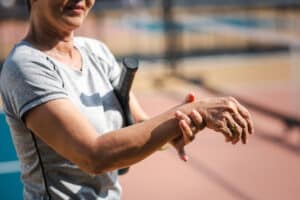 ☰ Menu
☰ Menu
Pickleball has been the fastest growing sport in the United States for the past four years. The game combines elements of tennis, ping pong and badminton into a new sport that’s played on a hybrid court blending properties of tennis and badminton courts. It is easily accessible to individuals of all ages, which is one of the primary reasons for its surging popularity. Whether you’re a young adult, a middle aged parent or a senior citizen, pickleball provides a great outlet for anyone craving a social outlet and some extra physical activity in their life.
The most recent data regarding the growth of pickleball highlights the sport’s tremendous popularity:
The rising popularity of pickleball is largely a good phenomenon, as it has helped a growing number of individuals across the country expand their participation in athletic activities. However, it’s important for pickleball players to understand that just as with all sports, there’s a risk of injury. A University of Arkansas study found that over 17,400 pickleball-related injuries resulted in emergency room visits in 2022 alone. Whether you’re new to pickleball or an experienced player, it’s important to understand the injury risks.
There are two different types of pickleball injuries:
In general, the prevalence of these injuries typically breaks down by age. Strain and overuse injuries, which are the most common type of pickleball injuries, primarily affect individuals under the age of 50. Pickleball players over 50, on the other hand, are more likely to develop acute or traumatic injuries associated with falls or abrupt pivots on the court.
The repetitive motions required when playing pickleball make players susceptible to overuse injuries. The more often you play, the more likely you are to develop one of these overuse injuries since your body is repeating these motions more frequently, often without sufficient time to recover from the strain placed on your muscles, tendons and ligaments.

Shoulder strain is another common overuse injury that occurs when your shoulder or rotator cuff becomes overextended during overhead swings. This can damage the muscles in the region, resulting in inflammation, pain and reduced range of motion. In severe cases, this overextension of the muscles can result in a torn rotator cuff.
The quick and repetitive footwork required when playing pickleball can place stress on the Achilles tendon, which connects the calf muscle to the heel bone. This can result in tendonitis, which causes pain and inflammation that impacts your mobility.
Repeated bending, twisting and sudden directional changes while playing pickleball can result in knee strains. Some of the most common include:
Poor posture, improper technique and sudden twisting or bending movements can result in lower back pain.

Wrist, arm and hand fractures can occur from falling on the court with an outstretched arm to break your fall. While less common, fractured legs and ankles can also occur during pickleball.
Knee, wrist and ankle sprains can occur from falls, twisting movements or abrupt pivoting motions.
Dislocated shoulders can occur if you fall on your shoulder or experience an extreme twist in your shoulder joint. This type of injury causes your upper arm bone to pop out of the shoulder socket.
Pulled hamstrings can occur while lunging for a ball on the court. These injuries are very painful and can result in stiffness and weakness in the back of the thigh.
If you’ve suffered a pickleball injury, Colorado Advanced Orthopedics can help you restore a pain free life. Our team of board-certified, Fellowship-trained orthopedic surgeons and sports medicine physicians have extensive experience treating pickleball injuries. We can perform all necessary diagnostic assessments to determine the precise nature of your injury and recommend the right treatment plan.
In most instances, pickleball injuries can be treated with nonsurgical methods such as physical therapy. However, in cases of serious acute injuries, our orthopedic physicians can also perform any surgical procedure necessary to help you fully recover and get back on the pickleball court as quickly as possible.
Contact us today to schedule an appointment. Colorado Advanced Orthopedics serves patients in Meeker, the White River Valley, Grand Junction and throughout the Western Slope.
Subscribe to our monthly newsletter for the latest tips and insights on orthopedic health, wellness, and recovery. Discover how to celebrate life to the fullest!
Subscribe To Our Monthly Publication